Spider Bites on Dogs Urgent Symptoms & Treatment Tips
Spider bites on dogs are anything from mild irritations to severe medical emergencies based on the species of spider and the reaction of the dog. Many of us pet owners wonder if our dogs are at risk of being bitten by a spider or is really just a small nuisance. If your dog is bitten by a spider at certain times of the year, it’s important to know when to call the vet for your dog, and what to do if your dog is bitten at home.
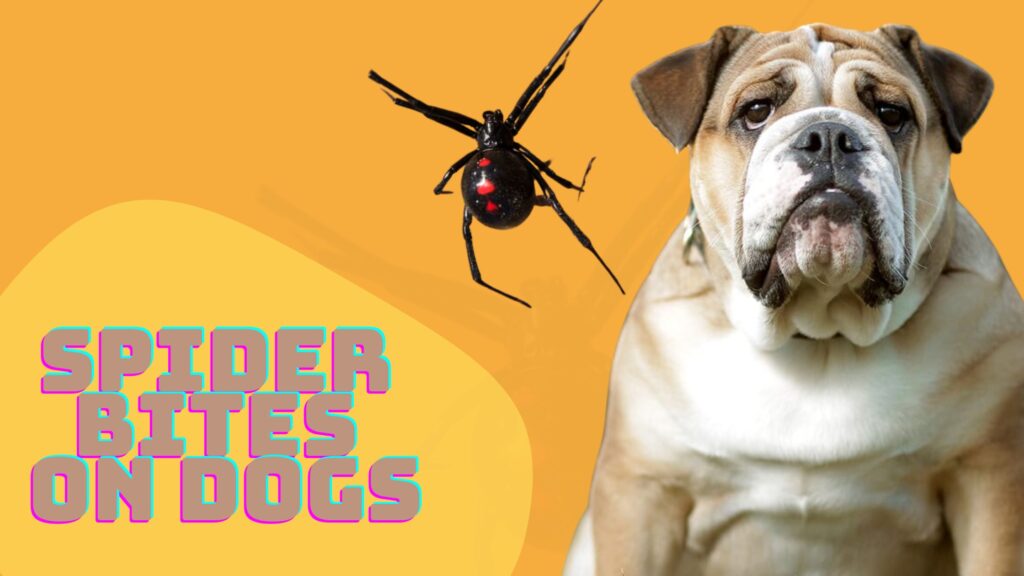
The right information will help pet owners to correctly handle Spider Bites and if the need arises call a professional. This guide offers advice on how to identify symptoms, administer first aid, and indeed when to take your dog to the vet if they’re bitten by a spider.
Can a Spider Bite Hurt My Dog?
Spider Bites on Dogs can hurt dogs, although the degree of pain depends on the type of spider and the amount each dog is sensitive to. Most Spider Bites on Dogs produce a mild amount of discomfort. Some, however especially those of black widow and brown recluse spiders are venomous enough to cause more serious health complications.
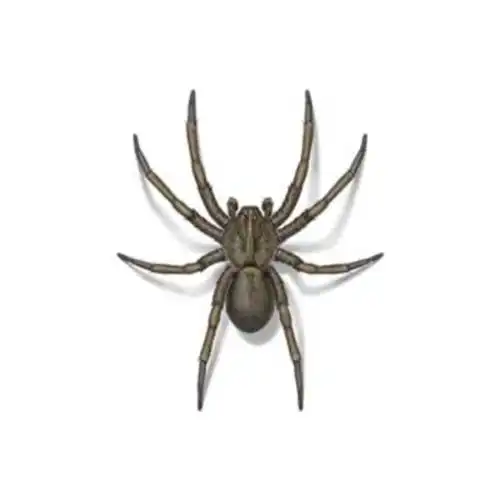
While not all species of wolf spider bite are venomous, these spiders do have a venomous bite that can bring intense pain, swelling, and even systemic reactions if untreated. Other common spiders, like wolf spiders, can produce only mild symptoms, though any bite can be uncomfortable for your pet.
The bite area may also become a target for the dog to try and paw or lick it increasing the risk of infection. The first step in protecting your dog and reducing the chance of worse reactions to Spider Bites on Dogs is to recognize the symptoms.
What to Do if a Spider Bites My Dog
If you suspect that a Spider Bites on Dogs, follow these steps to help manage the situation safely:
- Inspect the Bite Area: First, look into your dog’s skin. You should also look for swelling, redness, or visible puncture marks around the eyes if your child has caring for them. The tender area inside the foot should be treated with care and not inflamed any further.
- Keep Your Dog Calm: Anxiety or agitation played by pain could raise a dog’s heart rate and spread the venom. This can be kept down by keeping your pet calm and relaxed.
- Clean the Area: Cleansing the bite area with mild soap, and warm water. If there is a build-up, gently pat the area dry with a clean cloth which reduces the chance of infection.
- Apply a Cold Compress: A cold compress placed on the bite helps minimize swelling and numbs the area, so it is helpful. Apply ice in a cloth, wrap the ice in cloth, and leave it on for about 10 minutes and check regularly to prevent frostbite.
- Monitor Symptoms: Keep a close eye on your dog for worsening symptoms like swelling that is getting worse, vomiting, difficulty breathing, and lethargy.
- Contact Your Vet: Call your vet immediately if your dog shows extreme symptoms or if you think the bite was from a poisonous spider, like a black widow or brown recluse. A few types of venomous Spider Bites on Dogs can be life-threatening in dogs.
Symptoms of Bites in Dogs
The dog’s symptoms will vary according to how toxic the spider venom is to the dog and the dog’s size, age, and health. Here are common symptoms to look out for:
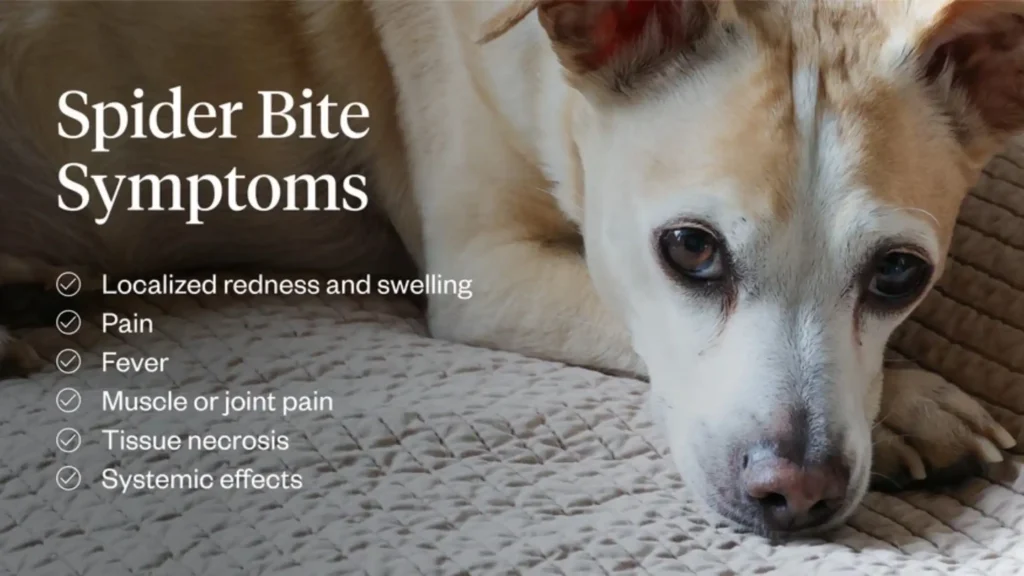
- Swelling and Redness: Most bites are enough to cause localized swelling and redness. This is typically the first sign something’s not right, often accompanied by pain in your affected area.
- Itching or Licking: So dogs may start to lick at or scratch the bite site to help alleviate the discomfort, which will further irritate or infect it if not treated.
- Pain or Sensitivity: If you touch the area around the bite, a dog may yelp or show discomfort indication.
- Lethargy: As the body reacts to the venom, some spider bites of course can make your dog feel a bit tired and lethargic, and some are venomous so it’s worth getting this checked out.
- Vomiting or Loss of Appetite: In more severe cases dogs may become nauseous, vomit, or lose interest in eating.
- Muscle Tremors or Difficulty Breathing: This means they are signs of a more serious reaction and you need to have the animal rushed to the veterinarian for care. The bites may also come from venomous spiders like black widows.
Is My Dog’s Spider Bite Dangerous?
The danger that a spider bite to your dog poses will depend on the type of spider, where the bite occurred, and your dog’s health. Black widows brown recluses, and some other spiders, have venom potent enough to cause severe symptoms or even life-threatening conditions in some dogs.
Factors Affecting Bite Severity
- Spider Species: Black widows or brown recluses are venomous spiders that can give you a bite that may cause serious medical problems.
- Dog Size: Unfortunately, smaller dogs may have more severe cases since their weight is less while bigger dogs may get away with a little better.
- Location of Bite: More concerning bites may occur on the face, neck, or body parts, as the venom may spread faster when they bite blood vessels close to the surface.

How to Treat Bites on Dogs at Home
- Clean the Bite Area: Wash the area gently with gentle (mild) antiseptic soap and warm water. Instead of harsh chemicals or alcohol-based products, you should try to avoid these because they will irritate your dog’s skin.
- Apply Cold Compresses: Soothing the bite area is one trick: a cold compress can help reduce swelling. To treat a bee sting, hold a clean cloth that has a couple of ice cubes inside and place it on the bite for 10 minutes. This should be done again every couple of hours, as needed.
- Prevent Licking or Scratching: Lick or scratch the bite: Prevent by using an Elizabethan collar or other method. Over-licking can cause the bite area to become inflamed and infection is a possibility.
- Use an over-the-counter Antihistamine (If Approved by Vet): Sometimes something like an antihistamine like diphenhydramine (Benadryl) can help ease itching and swelling. Nevertheless, don’t give any medication to your dog without speaking to your vet first so that you know it is safe for your dog.
- Monitor Your Dog’s Behavior: If the dog is yours, watch your dog for any changes, especially in the first 24 hours. Call your vet if symptoms get worse, or new symptoms present themselves.
How to Identify a Spider Bite on a Dog
Spider Bites on Dogs can be difficult to identify because they resemble other bites or irritations of the skin. Here are some distinguishing characteristics:
- Visible Puncture Marks: Spider Bites on Dogs come in two varieties: two puncture marks close together, or a puncture mark always in the shape of a puncture.
- Localized Swelling: It can be swollen and red in the bite area. If the bite is venomous, it can swell into surrounding tissue.
- Increased Warmth: In some cases, bites can sometimes cause localized heat in the bitten area.
Spider Bite Swelling on Dogs
A spider bite in dogs is one of the most common symptoms, along with swelling. Here’s how to manage it:
Cold Compresses: In use, a cold compress will help control swelling and relieve pain or irritation.
Avoid Heat: Don’t put your hands or anything else on a bite unless it is a non-venomous bite because you will increase the blood flow and spread the venom if it is a venomous bite.
Keep Your Dog Calm: Swelling may extend if excitement or activity causes it. This helps reduce your dog’s risk of being too calm and relaxed.
Spider Bite vs. Allergic Reaction in Dogs
A spider bite and an allergic reaction can be hard to tell apart. Here’s a quick guide to help you tell the difference:
- Bite Marks: Spider Bites on Dogs can have clearly visible puncture marks, whereas allergic reactions typically cause a patch of raised welts or a large red area with no apparent beginning.
- Swelling Location: Spider bites generally cause swelling around the bite area only, while an allergic reaction would generally result in swelling of the body as a whole.
- Behavioral Signs: Spider bites or allergic reactions often lead to scratching /biting on a large area or just a point while spider bites or allergic reactions often cause itching or scratching over a large area.
Signs of Black Widow Bite in Dogs
Black widow spider bite is one of the most dangerous to dogs and recognizing the signs fast is vital. These bites are venomous and cause severe symptoms including small or older dogs. Here’s what to look out for:
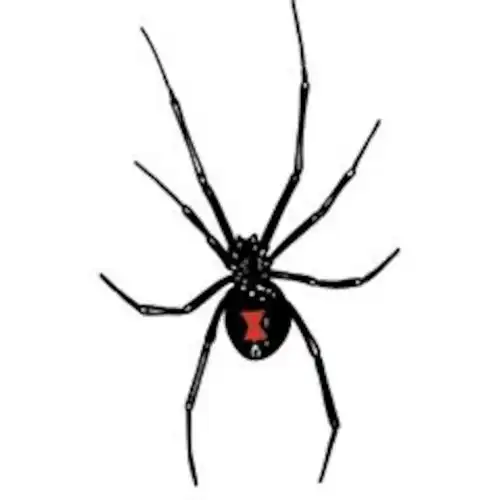
- Muscle Tremors and Rigidity: The black widow is venomous but black widow venom doesn’t affect the heart and doesn’t kill, but it does affect the nervous system and can cause muscle tremors, spasms, or stiffness, especially in the abdomen and legs.
- Weakness or Paralysis: A dog may be weak, unsteady, or have trouble standing. In very severe cases, partial paralysis can be seen.
- Vomiting or Drooling: A black widow bite can cause nausea, extreme drooling, or vomiting in some dogs.
- Labored Breathing: Severe difficulty breathing is a sign of systemic venom reaction and a serious emergency, a symptom needing immediate veterinary care.
Brown Recluse Spider Bite in Dogs: Symptoms and Treatment
Dogs are also at risk of a serious bite threat from brown recluse spiders, and if someone doesn’t real the bite, seek medical attention as soon as possible it may cause serious harm to the dog. Here are the primary symptoms and recommended treatments:
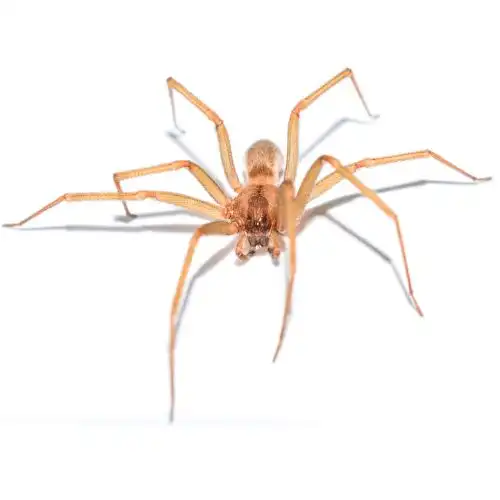
Symptoms of a Brown Recluse Bite
- Reddened, Swollen Area: There may be an initial, red, swollen bite area that becomes a painful blister.
- Tissue Necrosis: The bite from a brown recluse can give you tissue damage around your wound. It is possible that in a few days the skin will darken and break down producing the appearance of a wound.
- Fever and Lethargy: Brown recluse Spider Bites on Dogs can cause a dog to have a mild fever, lethargy, and a general decrease in energy.
- Lack of Appetite: Dogs may stop eating because of pain or discomfort from the bite.
Treatment for Brown Recluse Bites
- Clean the Wound: Simple soap and water can be gently washed on the area to help prevent infection.
- Apply a Cold Compress: A cold compress may help reduce the first hump of swelling, and alleviate some discomfort.
- Seek Veterinary Care: You should have the vet assess the wound because of the risk of tissue necrosis. It’s possible they’ll prescribe antibiotics to keep you from getting an infection and pain medications.
Preventing Spider Bites in Dogs
Preventing Spider Bites on Dogs involves a few proactive steps to minimize your pet’s exposure to potentially harmful spiders:
- Keep Indoor and Outdoor Areas Clean: Regularly clean areas where spiders might hide, such as garages, basements, and outdoor sheds. Inside hard-to-reach places such as corners of your house or in furniture areas where spiders like to build their web.
- Limit Access to Spider-Prone Areas: It is important that you prevent your dog from going to those areas where spiders are high, like at night when spiders are highly active.
- Use Pet-Safe Pest Control: Bringing the spider population down can be accomplished using pet-safe insecticides or even natural repellents.
- Shake Out Bedding and Blankets: If your dog sleeps in a bed or blankets in a spider-prone area, shake these out regularly for spiders hiding inside.
When to See a Vet for a Spider Bite on Your Dog
- Severe Swelling or Pain: If there is a huge swelling of the bite site and it’s causing visible pain, it’s best to get a vet looking at it.
- Difficulty Breathing or Muscle Tremors: In any case, be on the lookout for signs of respiratory problems, tremors, or stiffness, all of which might indicate a venomous bite.
- Worsening Symptoms Over Time: If the bite area gets larger and it looks red, warm, or leaking over 24 to 48 hours, that may be due to infection or venomous tissue damage.
- Loss of Appetite or Lethargy: Signs that your dog may need medical support include changing behavior like lethargy, no appetite, and unwillingness to move.
- Open Wound Formation: An open wound following n a bite is medically serious if it develops with necrosis and immediate medical attention is necessary to prevent more damage to tissue.
Natural Remedies for Spider Bites on Dogs
- Aloe Vera Gel: Aloe vera is naturally cool and anti-inflammatory. Massage tiny splashes of pure aloe vera gel on the affected bite area for some relief from irritation and a reduction in redness.
- Calendula Ointment: Calendula ointment is known for its skin healing properties and can be used to alleviate itching, and help healing.
- Epsom Salt Compress: Mix a small amount of Epsom salt in warm water, and soak a clean cloth, to apply as a compress. It can help alleviate the inflammation aspect of the bite and clean it out.
- Coconut Oil: The natural antibacterial properties of coconut oil will help moisturize the area and skin at the same time. Rub a thin layer into the bite area to help heal it.
- Chamomile Tea Compress: Put a chamomile tea bag in, let it cool, and put it onto the bite as a compress. Chamomile is well known for its soothing and anti-inflammatory effects.
Final Words
Spider Bites on Dogs aren’t always dangerous to your pet, but knowing what symptoms to watch out for and where to start with first aid can make all the difference. You want to know what to look for as potentially serious symptoms of bites from a black widow or brown recluse.
Preventative measures can be slightly utilized along with vigilance to avoid spider issues and protect your furry good friend in well-being and consolation. If your dog gets bitten by a spider, see a veterinarian if you’re at all unsure.
The difference is, that with a bite from something venomous, prompt professional care makes a difference. If you do not know for sure what you will be facing when you open the front door in the morning, staying informed will enable you to give your dog the best quality care and comfort when a spider bite or other incident occurs.
What does a spider bite on my dog look like?
These Spider Bites on Dogs are like mosquito bites, small red bumps that are virtually painless to your dog. According to most people, they can be treated in a variety of ways that are natural and result in itch relief. Not all dogs will even feel any irritation.
What can I put on a spider bite on my dog?
Your pet is treated with an antivenom, IV fluids, cleaning solutions, pain medications, or antibiotics depending on the type of bite. These ice packs can help the swelling and may be irritating. Cleaning with soap and water and baking soda and water paste are some other home remedies for nonvenomous bites.
How long does it take for a dog to react to a spider bite?
The great majority of bites are due to the dog lying on or walking over the spider. The pain doesn’t usually occur right away when bitten; however, signs may not manifest themselves for up to 4-8 hours. It is a red itchy skin lesion that develops around the site. Sometimes the bite has a look resembling a bullseye with a white center or a ring around the outside.
What will a vet do for a spider bite?
Your veterinarian will clean the wound thoroughly and apply cool compresses if your dog has a Brown Recluse spider bite. In certain cases, antibiotics may be needed to prevent infection.
